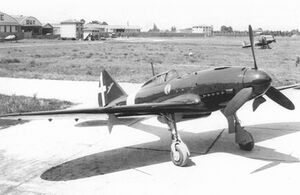Viborn Type-22
| Viborn Type-22 | |
|---|---|

| |
| Type-22 at Rekov Proving Grounds | |
| Role | Fighter |
| National origin | Librira |
| Manufacturer | Viborn Aeronautics |
| Designer | Feodor Dukanov |
| First flight | March 20th 1941 |
| Introduction | July 13th 1942 |
| Retired | 1960 |
| Status | Retired |
| Primary user | |
| Produced | 1940 - 1954 |
| Number built | 5,000+ |
| Program cost | 4.6 Million $A |
| Variants | Viborn Type-42 |
The Viborn Type-22 was a Libriran monoplane fighter and fighter-bomber developed during the 2nd Global War by the Libriran Aeronautics firm Viborn Aeronautics for service in the Military Air Service. Alongside the La-105 and later La-115 the Type-22 formed the core of Libriran Air superiority aircraft during the conflict. The aircraft was very aerodynamically refined and took full advantage of the new Viborn D-550 a 12-cylinder Turbo-Supercharged water-cooled engine, that could use Mw-50 injection to further boost power output. The Type-22 was well-liked by its pilots, but somewhat unpopular with its ground crews, it flew very well, but its complex workings meant they required work often, and their engine bays were cramped.
Design and Development
The Type-22 was the culmination of an over decade long effort by Viborn to develop a successfully forced induction engine and introduce it into an airframe that could use its potential. Viborn designers in both the powerplant and airframe departments collaborated in an unprecedented effort to build a plane that was built around its powerplant.
Design work began in 1930 with small scale models being used in Viborn's Wind Tunnel #2 for general testing. Design work continued to be refined into the mid 1930s, with the type-22's first full scale model being built in 1936. However, the type was not ready for the 1937 Fighter Aircraft trials, and the LA-105 won easily in face of no Challenger from Viborn. The project hit snags in the late 1930s due to unreliable metallurgy in forced induction components, which required aditional investment for Viborn to establish production of the needed parts to finish the D-550's design work. The airframe by this point was considered ready to a prototype, however, delays in the engine meant that this would not begin until after the 2nd global war had begun.
Work slowed in the early days of the war as the majority of Viborn's time was taken building LA-105s for the MAS. However, a small group of engineers continued to fiddle away, and brought the aircraft to the factory airfield for its first tests in 1941. The project flew well on its first flight but required some additional work, as well the MAS was concerned primarily about the number of aircraft in the air, and switching production away from the LA-105 would cost previous airframes. As a result the Type-22 has a baptism of fire before it had even undergone state trials, by flying in defense of the Viborn factory during Dasmaran Airstrikes.
Initially armed with 4x 12mm machine guns, this early combat experience showed that heavier armament was required, and as a result, was changed to 2x 15mm HMGs and 3x 20mm Cannon. As well the aircraft was given access to MW-50 injection, which further boosted performance, particularly in climbs and at altitude.
In 1942 with the war situation improving for Librira, the aircraft was finally shown to the MAS, who accepted into service under a trial basis, ordering 50 aircraft and allowing Viborn to free-up a production line to make them. The aircraft received much praise in its combat trials, and its complete superiorty over the LA-105 and to and extent the LA-115 meant that an additional contract was issued for 1,000 aircraft.